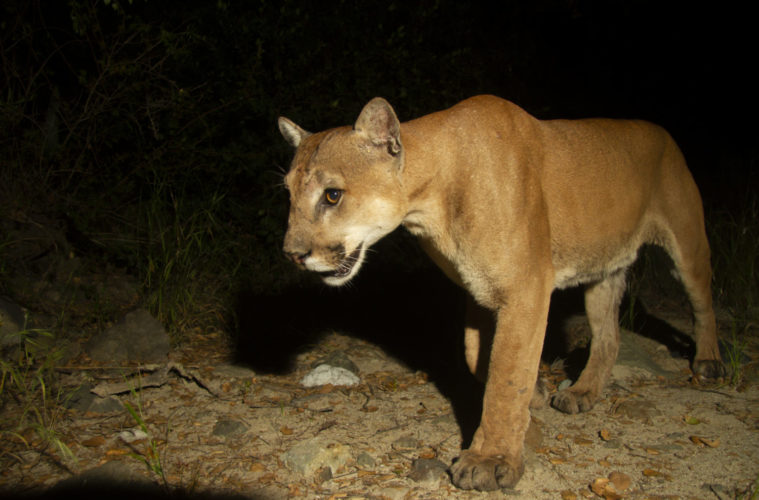The shooting death of a recently collared male mountain lion living within the Santa Ana Mountains, known locally as El Cobre, is currently being investigated by the the California Department of Fish And Wildlife.
On Friday, July 2, CDFW Captain Patrick Foy confirmed that the carcass of a male mountain lion, equipped with a tracking collar, had been found in eastern Orange County, but that there were no suspects or additional information.
“We do have a dead [mountain] lion and we have started an investigation, but I’m afraid that it’s one of those things where we are so early in the investigation that we would like to decline to disclose any details,” Foy said on a phone call with Irvine Weekly. “This is very, very fresh.”
Foy added that CDFW could use the public’s assistance in helping identify the suspect who may have shot El Cobre.
“If anyone has any additional information they could share with us, to help identify a suspect or any kind of witness activity involving this dead lion, they can use our CalTip number,” he said. “As wildlife officers and investigators, we try to identify any type of evidence – the carcass itself is a primary evidence item, and we have that. We look for what the cause of death was and backtrack to see where did this lion come from — it has a collar on it – that’s something that we’re going to be taking a look at as well.”
Foy confirmed that El Cobre was not killed by CDFW.
Officially marked M294, El Cobre, also known as Scar, was the same animal that was found trapped inside a livestock enclosure near Williams Canyon in May. On May 20, mountain lion expert Dr. Winston Vickers, of UC Davis, fitted El Cobre with a tracking collar, and relocated him after the 125-pound cat was found trapped in the same Williams Canyon enclosure he had killed a goat in a few weeks prior.
At the time, in May, Vickers underscored El Cobre’s significance to the region, as the five-year-old cougar became the first new wild cat to be collared — giving community scientists a beacon on hope for the struggling populations.
Mainly, Vickers was interested to learn if El Cobre had been producing kittens, and if the animal had successfully crossed the Interstate-15.
“We had never captured him before. He’s somewhere in his middle years, he’s mature. He’s number one for now — he was an unexpected addition, we weren’t looking to start collaring yet,” Vickers said in a phone interview with Irvine Weekly, while en-route to El Cobre’s relocation on May 20.
After learning about El Cobre’s death, Vickers emphasized his disappointment, adding that El Cobre was a treasured rarity, both regionally and in terms of the data he could provide – considering the genetic plight of the Santa Ana mountain lion population.
“Obviously I’m never happy about losing any mountain lion this way, and our study animals represent a lot of hours and money invested to get those collars purchased and onto the animals so that we can learn about them,” Vickers wrote in a text to Irvine Weekly. “M294/’Scar’/’El Cobre’ was quite an interesting animal at several levels, so really hate to lose him – but this is the situation we have found ourselves in all too often in our study of the regional mountain lions. Their high mortality rates overall mean that we have to deal with the loss of study animals.”
Korinna Domingo, director of the Cougar Conservancy, a Los Angeles-based non-profit organization working to reduce human harm within the mountain lion populations living within Southern California, said she works closely with Vickers, and was on site when Vickers collared El Cobre.
The Cougar Conservancy referenced El Cobre’s death in a post via its website on June 30. While Cougar Conservancy’s post does indicate the animal was shot, Domingo said she cannot confirm if animal was killed without a permit, nor if a member of the community is responsible for El Cobre’s death. Domingo advised to follow up with the CDFW investigation for those details.
“We were made aware by the naturalists and community scientists who follow him – they started reaching out to me this week with concerns that they had heard rumors that he had been shot and killed,” Domingo said in a phone interview. “We’re really confident in the department’s [CDFW] ability to conduct a really thorough examination in this case.”
She did, however, confirm that El Cobre’s body was found within the Santa Ana Mountains.
Domingo also said she visited the property and spoke with the owners of the livestock enclosure El Cobre was found trapped inside of twice before his death. However, the owners declined the Cougar Conservancy’s offer for a free cougar-proof enclosure for livestock.
“We actually found where El Cobre fell through the roof [in the Williams Canyon enclosure] — we actually confirmed that with hair. We’ve given away multiple cougar-proof enclosures — and unfortunately in this case even though this resident had trapped this lion twice, they actually ended up refusing any assistance, which actually blew our minds. But it’s not the first time.”
El Cobre was not found on the Williams Canyon property. Due to the ongoing investigation, the exact location will be withheld as this is a developing story.
The public is encouraged to contact CDFW’s CalTip hotline at 1-888-334-CalTIP with any information regarding this case.
Advertising disclosure: We may receive compensation for some of the links in our stories. Thank you for supporting Irvine Weekly and our advertisers.

